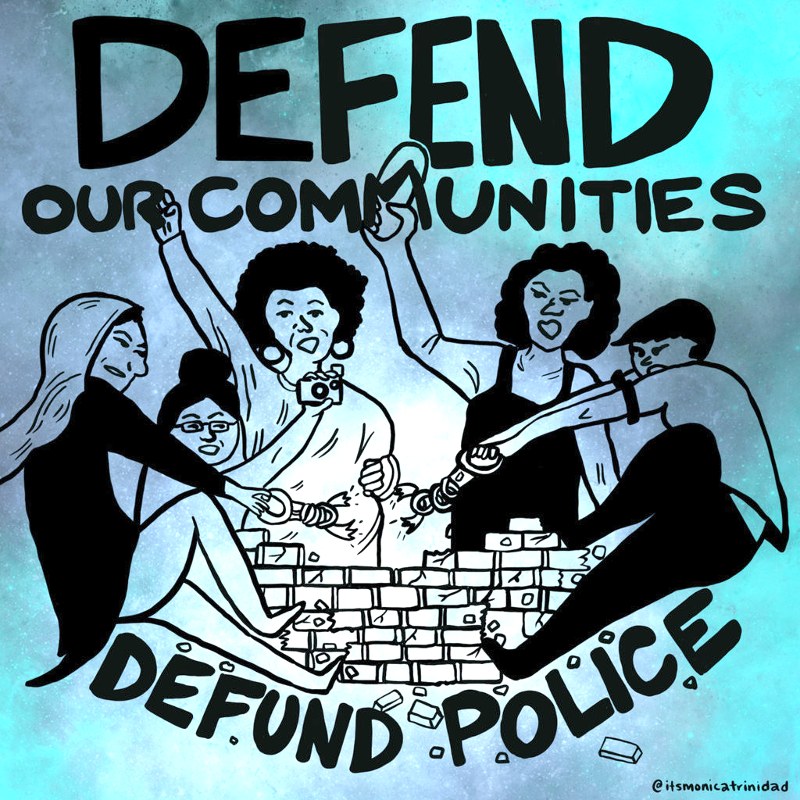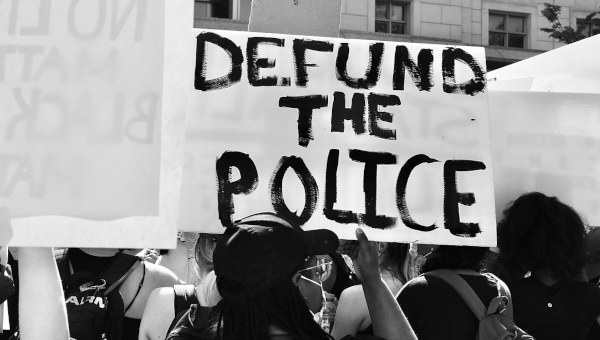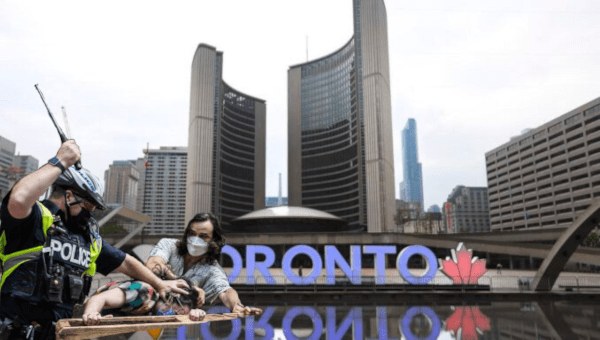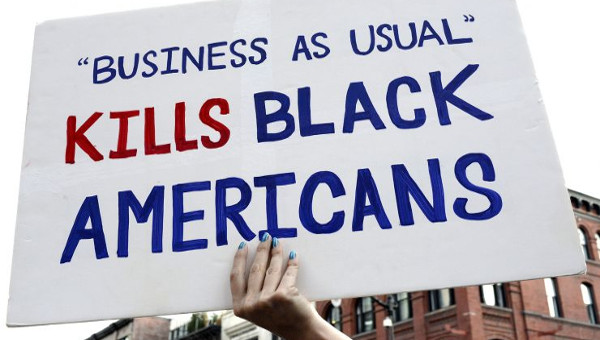Three Measures Against Racist Policing
Protesters against police brutality and racism have gathered to demand systemic change since the end of May, holding events in all 50 US states and around the world. Impelled by the police murder of George Floyd on May 25, the protests amplify a long-standing call by social justice organizations, Black civil rights leaders like Angela Davis and many others for decades: dismantle, defund and/or abolish America’s racist and heavily militarized policing systems – and replace them with community-led safety programs and public health initiatives. The movement’s leadership has made it clear that the protests, many of which have been non-violent due to community participation, are calling for more than updates to existing police training programs or reforms within existing police departments. Rather, they are calling for America to rethink the response to crime and safety overall. They are calling for cities to reallocate funding away from police and begin the steps to gradually dismantle the policing system altogether, as Eric Levitz writes in a recent New York Magazine article.

The police response to the protests against police brutality in many cities has been markedly, and ironically, brutal, as is discussed in detail in a recent article by Adam Gabbatt in The Guardian. Many videos and reports from recent protests show police using violent force against peaceful protesters. Dounya Zayer spoke with Democracy Now! about the police officer who violently pushed her to the ground when she was peacefully protesting, which she said resulted in a concussion and a trip to the hospital. Across the US, police have arrested more than 10,000 protesters and have repeatedly attacked journalists covering the protests, including Linda Tirado, who has been partially blinded after the police shot her with a foam bullet in the eye.
Meanwhile, the protests are successfully pushing officials across the country to respond in some tangible ways. Cities, counties, states and some police precincts across the nation are implementing changes, small and large, and the moment has brought the deep-seated problems of the policing systems into the mainstream conversation.
Demanding Far-Reaching Justice and Systemic Changes
On June 12, amid the mass protests against police killings, police in Atlanta shot and killed a 27-year-old Black man named Rayshard Brooks. Atlanta police chief Erika Shields immediately fired the officer after the fatal shooting of Brooks, and the officer is now facing murder charges. The autopsy report listed Brooks’ manner of death as a homicide. Atlanta’s Mayor Keisha Lance Bottoms has ordered changes to the police use-of-force policy following the incident. The immediate firing of the officer and response of the mayor – while small steps – both speak to the work of the protests. In the past, many police killings of Black men and boys have gone undisciplined or resulted in a period of paid leave or slight demotion of the officers responsible. Since the death of Brooks, protesters have been filling the streets of Atlanta to demand more far-reaching justice and systemic changes.
The protests are beginning to push public dialogue to question long-held assumptions about what the safety of the future can look like. The US is starting to reckon with its systemic racism in an unprecedented way. Boston’s Mayor Marty Walsh recently declared racism a public health crisis. Because of the protests, several US cities have also started to defund their police programs and reallocate those funds for other public services.
Following public pressure after the wrongful police killing of Breonna Taylor, in which police stormed the house of the 26-year-old medical worker in the middle of the night on March 13 and shot her to death, Louisville has passed Breonna’s Law to ban no-knock police warrants in the city (though the officers responsible have not been charged for Taylor’s murder yet).
There is some concern among protest organizers that changes enacted now could be short-lived, and eventually lead back to the same old cycles of oppression and inequity. Alicia Garza, the principal of Black Futures Lab, the director of strategy and partnerships for the National Domestic Workers Alliance and a co-founder of the women’s activist group Supermajority, said in a New York Times Q&A discussion recently that “political will over the long term” will be necessary in order for real change.
“I think there is a danger now that when protests start to die down, which they always do, when the blue-ribbon panel is dismantled, which it always is, Black communities won’t necessarily be in a more powerful place than where we started,” she said in the New York Times interview. “The country has to deeply invest in the ability of Black communities to shape the laws that govern us.”
Which policy changes and actions can actually restructure the US’s problematic policing and justice systems? Here are a few of the concrete changes that leading organizers are calling for, with the potential to shift how policing, safety and justice systems operate in the future.
1. Defund and demilitarize the police and reallocate those funds into community-based programs like safe housing, social care programs and public health.
Many police budgets in the US are disproportionately bloated when compared with other tax-supported social services. The nationwide trend over recent decades has been to gradually increase police budgets, while schools, welfare programs and other public services have encountered widespread budget cuts. As the original Black Lives Matter protests that began in Ferguson in 2014 brought to light, police in this country – even in smaller precincts – are heavily militarized. Angela Davis pointed this out in a recent interview, in which she discussed how America’s “police departments are the most dramatic expression of structural racism.”
Calls by organizers to defund the police make it clear that defunding is just the first in a multistep movement to dismantle policing as we know it. But it’s an important starting point, as it has the capability to free up needed resources for community-based social services and public health services.
Several cities – some of them for the first time – have started to take that first step and reduce their police budgets, to varying degrees. For example, in Austin, the city council on June 11 voted to reinvest police funds and restrict use of force after recent police violence against protesters sent at least 31 people to the hospital. San Francisco’s Mayor London N. Breed also announced a new plan on June 11 under which the city will redirect some of its police funds into organizations that serve communities that have been harmed by systematic racism, and police will no longer respond to non-criminal calls or use military-grade weapons and gear. New York’s Mayor Bill de Blasio has promised for the first time to cut funding for the NYPD. Portland plans to decrease its police budget by $15-million.
It’s notable that many cities are now cutting police funding, especially since prior to the protests many of those same cities were set to increase police budgets this year. That said, defunding is just a small first step to rein in a long-militarized, violent and racist system. Brie McLemore outlines the need to do more than defund the police, in a recent Truthout article in which she argues for the abolition of police.
A stronger shift that comes closer to the changes protests are calling for is coming out of Minneapolis, Minnesota, where George Floyd’s murder led to the first of the recent protests against police brutality. The Minneapolis City Council has vowed to eliminate its current police department and replace it with a new model of community-led safety programs. The city is also working with the Minnesota Department of Human Rights on an investigation into the Minneapolis Police Department over the last decade. The department has received numerous complaints about the racially targeted and brutal treatment of citizens, and has repeatedly failed to hold cops accountable for their actions. Meanwhile, community organizers in the city are already implementing programs, led by community members that rethink safety, as outlined in a Truthout op-ed by Jae Hyun Shim.
Aqeela Sherrills is an organizer who has been working to shift the conversation around safety and violence in America for more than three decades. He has been working with cities on the ground to replace over-policing with community-led safety programs. He is a senior adviser to the Alliance for Safety and Justice (ASJ), which works with several states to replace over-incarceration with crime prevention, community health, rehabilitation and crime-survivor support programs. He is also the co-founder of Crime Survivors for Safety and Justice (CSSJ), which is a project of ASJ and a national nonprofit network of crime survivors, working to replace criminal justice and prison system waste with community-based initiatives. Sherrills has been working for six years with the city of Newark, New Jersey, to implement many of the systemic changes that protesters are currently calling for. The implementation of community-led strategies has meant notable drops in crime rates throughout Newark, which is historically high in crime.
Sherrills was at the helm of a groundbreaking peace treaty between the Bloods and the Crips in Watts, Los Angeles, in 1992. He says to successfully bring about crime reduction and safety, it’s essential to rethink the way people view and speak about criminality. What his experience has taught him is that the best approach is to treat violence as a public health issue, and work with actual community leaders on safety programs – and in high-crime areas, those leaders can be ex-convicts or gang members, as he details in a recent interview with the Independent Media Institute.
Sherrills says in the interview that urban street-gang wars are what many social justice activists call, “the longest-running war in the history of this country.” But, he says, the survivors and victims of that war have been criminalized rather than met with supportive services to heal the traumas and impacts of violence.
“We didn’t give ourselves that label [of gang]. That label was meant to dehumanize the person behind it, and desensitize the public to the plight of these youth and young adults who were growing up in these war zones. Instead of providing healing services, they provided a criminal justice solution to what was a public health challenge,” Sherrills said. “My whole adult life, I’ve been committed to shifting narratives around victimization and redefining public safety with the idea that we have to put the public back into public safety… Today, we’re at an inflection point. We have a real opportunity that’s ahead of us. There’s a national campaign to defund police.”
While Sherrills is not an advocate of completely getting rid of the police, he has long worked toward reallocating significant portions of police funding into community programs. And the programs he has helped to build offer real-life proof of how community-based safety can be more effective than police in reducing crime. During recent protests, for example, the city of Newark has kept its police to the sidelines, away from people protesting, and it demilitarized the police by prohibiting riot gear and military-grade attire and weapons. The city deployed its organized and trained community groups to help keep things safe and civil. As a result, Newark has not had reports of police brutality seen in many other American cities, and they’ve had weeks of peaceful protests without looting or serious property damage.
“We deployed the [Newark Community Street Team], the West Ward Victims Outreach [Services], the Newark Anti-Violence Coalition, the mayor’s Brick City Peace Collective – these are all residents of the city,” Sherrills said. “We weaved ourselves through every single portion of the march.”
2. Remove all police from schools. Reinvest in counseling and education instead.
In Portland, Oregon, Superintendent Guadalupe Guerrero recently vowed to remove all school resource officers – police officers deployed to work at schools – from the district’s schools. This is something the city council’s only Black member, Jo Ann Hardesty, has been urging for years, as in-school officers disproportionately arrest Black students. Portland is not alone. Superintendents in Seattle, Minneapolis and Denver have vowed to end their school officer programs for similar reasons, and the disproportionate arrests of Black students in schools is a nationwide issue. Public pressure around the topic continues to build in many cities.
Many civil rights groups and organizers – including prominent teachers unions in Los Angeles, Chicago and elsewhere – have been calling throughout the recent protests to remove police from schools. While most programs to bring police into schools were enacted in response to school shootings, there is a lack of evidence to show that they actually increase safety. There is, however, ample evidence that they make life harder for Black kids, as discussed in a recent New York Times article.
Many of the teachers’ groups and civil rights groups now calling to remove cops from schools have been doing so for years. The civil rights groups Advancement Project and the Alliance for Educational Justice released a joint report in 2018 that outlines the reasons removing police from schools is a step to improve school safety. As the report authors note in the introduction, the report “centers the voices of young people from around the country who describe the everyday indignities that they experience at the hands of school police. It also, for the first time, catalogues known assaults of young people by school police officers.”
The report explores the impacts of school police on students of color and Black communities in particular, and notes that in the two decades following the 1999 Columbine High School shooting, school discipline has grown increasingly punitive and has failed to increase safety in schools, especially for students of color.
“Safety does not exist when Black and Brown young people are forced to interact with a system of policing that views them as a threat and not as students,” the report authors write. “The report calls for the removal of police from schools and envisions schools where Black and Brown students are afforded the presumption of childhood that they deserve.”
While police budgets have been steadily rising for the last decade across the nation, education budgets have been slashed across the nation. The powerful union United Teachers Los Angeles (UTLA) has come out vocally in favor of the movement to eliminate police in the city’s schools, as the LA Times reports. Cecily Myart-Cruz, the incoming president of UTLA, reportedly told the Times, “We have to dismantle white supremacy. We must… defund the police and bring in the mental health services that our students need.”
The American Civil Liberties Union (ACLU) has been outspoken against police programs in schools for years due to the many racial disparities inherent in those programs. The ACLU’s website shows the negative impacts of these programs on Black and Brown students in particular. The website states:
“Though these police are often referred to as ‘school resource officers,’ their legal power and attending actions reveal that this designation only serves to mask that their presence has transformed schools into another site of concentrated policing. Such policing marks the start of the school-to-prison pipeline – the entry point to the criminal justice system for too many kids – and fuels mass incarceration.”
3. Decriminalize people for surviving.
In addition to calling for changes to policing itself, many activists who are seeking to end the problems associated with police brutality are also advocating for other reforms that decriminalize people for surviving. This means legally decriminalizing sex work, drug use and possession, homelessness and asylum-seeking immigrants. Organizers are also calling to change the way survivors of violent crimes are often themselves criminalized because of the way the systems are set up.
A report released this year by Nina Luo, a fellow for Data for Progress, details the necessity to decriminalize sex work as a first step toward protecting sex workers, and a “part of effective anti-trafficking policy. … Decriminalization includes amending penal codes and divesting from the criminal legal system (both police and prosecutors).”
Sex work is a relevant and mandatory part of the conversation around race and policing because entire police units, special undercover operations and significant resources are dedicated to policing sex work in the US. And, as the report notes, most often people who enter the sex trades do so out of economic desperation, in order to pay for their basic needs. Those sex workers are “often undocumented, women of color and/or young LGBTQ+ people who have little to no access to the justice system.” When these people are criminalized for attempting to survive via sex work, the “‘criminality’ as a result of engaging in sex work entirely discredits them as ‘victims’ when they report rape or violence to police.”
A national poll conducted by Data for Progress, published in January, found that “an outright majority of… [US] voters support decriminalizing sex work.” In the report, Luo explains how criminalizing sex work forces the trade underground, which ultimately endangers sex workers who might have been coerced into the trade, as they themselves could face charges if they speak about their work. The report also explains that sex workers enter the trade for a number of reasons – from choice to circumstance to coercion. And, again, most of them enter because of circumstance.
“Most sex workers trade sex out of circumstance to meet economic needs such as healthcare, housing or childcare,” the report says. “They may experience explicit discrimination in the formal economy because of disability, gender identity or immigration status and rely on sex work to meet basic needs. They may find parts of the sex industry to have low barriers of entry, allowing them to immediately access income for a short period of time in the industry before exiting. They may find that the freelance or independent nature of the work allows them more time flexibility to caretake families or pursue other interests.”
The report concludes with a reminder that criminalization has never effectively ended the sex trade, and that decriminalizing sex work is just a first step toward safety for people who do that work – and it’s the “only legal model that immediately reduces the harms of policing, incarceration, deportation, and criminal records in the lives of sex workers and trafficking survivors.”
As the US reckons with its long-standing racism and policies that enforce systemic inequalities, sex work and the criminalization of sex workers have to be part of the discussion. As Luo writes:
“Sex work is an issue of controversy because it forces us to reckon with the realities of economic, racial, and gender injustice. People trade sex for many reasons, but most often to meet basic needs, and until this economy affords everyone a home, a living wage job, healthcare, and education, many people will continue to trade sex for survival.”
As with sex work, the criminalization of drugs has been overtly ineffective and problematic. The four decades of the failed and innately racist US war on drugs are a systemic behemoth responsible for over-policing, primarily in non-white neighborhoods, and the mass incarceration that has disproportionately locked up Black and Brown people for decades. As the Drug Policy Alliance (DPA) wrote in a 2017 report calling for the decriminalization of drug use and possession:
“By any measure and every metric, the US war on drugs – a constellation of laws and policies that seeks to prevent and control the use and sale of drugs primarily through punishment and coercion – has been a colossal failure with tragic results. Indeed, federal and state policies that are designed to be ‘tough’ on people who use and sell drugs have helped over-fill our jails and prisons, permanently branded millions of people as ‘criminals’, and exacerbated drug-related death, disease and suffering – all while failing at their stated goal of reducing problematic drug use.”
Drug use is a public health issue, and it should be treated that way, as the DPA and many others have argued for years. Since Portugal, for example, made the groundbreaking decision to decriminalize all drugs in 2001 and turn drug use into a public health issue rather than a criminal one, the results have been overwhelmingly positive. Portugal’s opioid crisis, which was once among the worst in the world, quickly stabilized, and problematic drug use dropped significantly over the next several years. Hepatitis and HIV infection rates, overdose deaths, drug-related crime and incarceration rates also plummeted.
From the start, the war on drugs has targeted Black people, and other people of color, as author Michelle Alexander details in her book The New Jim Crow: Mass Incarceration in the Age of Colorblindness. In a 2014 interview, with the beginning of state-by-state cannabis legalization, Alexander discussed a trend in the emerging cannabis industry in which white men were getting rich, but many Black men remained in prison – and they still do. Several petitions to free people who are still serving life sentences for minimal cannabis charges have gained steam in recent years.
Homeless people are also criminalized in America for trying to survive. As the National Coalition for the Homeless explains, “The criminalization of homelessness refers to measures that prohibit life-sustaining activities such as sleeping/camping, eating, sitting, and/or asking for money/resources in public spaces. These ordinances include criminal penalties for violations of these acts.”
In the US, more than half a million people are homeless, and protesters are calling for an end of the criminalization of homelessness, and reallocation of police and justice system funding into safe housing programs to help people living on the streets.
And, among the conversations gaining some steam throughout the protests is the call to abolish US Immigration and Customs Enforcement (ICE). Currently, the US is still holding asylum seekers who came to the US hoping to escape dangerous situations, in horrific, overcrowded and illegal detention camps along the US-Mexico border. Children have been separated from their parents, and thousands of them have reportedly been misplaced. Detainees, including children, are living in squalor, treated inhumanely, locked in cages and dying in detention centers. ICE is the policing agency responsible for the operation. Throughout the recent protests, a petition has been circulating to stop reported spraying of ICE detainees with a powerful and toxic disinfectant, which is reportedly a practice being enacted in detention centers due to the COVID-19 pandemic. Protests are calling to do away with ICE and decriminalize asylum-seeking immigrants and all people who come to America looking for work and a better life.
In addition to decriminalizing the above sectors, protests are calling for the release of those currently incarcerated for these crimes. Some protesters are calling to take this further and begin to abolish the prison systems along with the police in order to bring about racial justice. The 2016 documentary film “13th” by director Ava DuVernay offers an in-depth breakdown of the racial disparities of prison systems, their ties to slavery and the continued oppression of Black Americans.
As a Reuters article reports, 40 per cent of the almost 2.3 million prisoners in the US are Black, while just 13 per cent of the US population is Black, according to the nonprofit Prison Policy Initiative. University of Ottawa associate professor of criminology Justin Piché told Reuters, “Something feels different this time,” in regard to the general response to recent protesters’ calls for racial justice. “Whether or not that actually translates into police defunding and more gains for prison abolition, that remains to be seen.” •
This article was produced by Local Peace Economy, a project of the Independent Media Institute.





